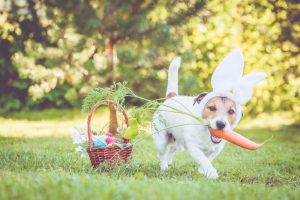When It Comes to Easter Pet Safety, Put All Your Eggs in One Basket
When It Comes to Easter Pet Safety, Put All Your Eggs in One Basket

Oh, the season of buds and blossoms has almost arrived! For many, this means that preparations for Easter egg hunts and family brunches (in tiny groups) are underway. Guess who loves to be underfoot in the kitchen or out in the backyard? The family pet, of course!
Pets may be just as excited as the kids are (or they could be hiding out until the holiday passes), but one thing is certain: without a cautious approach to Easter pet safety, they could be in danger.
A Huge Threat
Did you know that lilies are toxic to pets?
- Many people grow these perennials in garden beds; watch your dog closely when out for walks.
- Never allow your cat to get close to any variety of lily. Even the smallest amount of pollen ingested or inhaled can be catastrophic to their health. The leaves, stem, petals, and even the water in the vase are toxic.
- Watch for symptoms such as behavioral changes, vomiting, diarrhea, extreme thirst, seizures, and collapse.
- Seek emergency veterinary care.
Seasonal Delights
A significant threat to Easter pet safety is the very food that distinguishes the holiday.
- Holiday meals tend to have excessively fatty meat, rich foods, and poisonous ingredients like onions, garlic, and sage.
- Pancreatitis (inflammation of the pancreas due to a sudden increase in fat intake) is a common condition found this time of year due to the high-fat content in holiday foods.
- Please don’t delay seeking help for your pet if they show changes in their behavior, vomiting, diarrhea, lethargy, fever, and abdominal pain.
- Entice your best friend to enjoy a special, pet-safe meal made just for them by adding warm water to their food and let it sit for 30 min. You can also add white rice (unless they are allergic). That way, they (hopefully) won’t beg you guests for samples or give in to their curiosity around the buffet.
Easter Candy
Chocolate presents very real risks to pets that eat it, and this time of year it abounds. Always keep chocolate candy off the floor and beyond your pet’s reach. Dark chocolate and baker’s chocolate have the highest levels of methylxanthines, including caffeine and theobromine, and cause dangerous side effects like hyperactivity, increased heart rates, diarrhea, vomiting, and seizures.
Similarly, sugar-free candy is often made with Xylitol. Responsible for causing a severe drop in blood sugar, Xylitol poisoning can lead to organ failure and death. Never allow your pet to access sugar-free products including jellybeans, gum, mints, toothpaste, vitamins, or baked goods.
Easter Pet Safety
Easter baskets may look like they’d pose very little risk to your pet, but to truly uphold Easter pet safety methods it’s best to keep them off the floor. The artificial grass can do a number inside a pet’s GI tract, leading to painful obstruction and requiring surgery. Foil or plastic candy wrappers can be very attractive to hungry pets, but when swallowed, create similar hazards.
When your family conducts the egg hunt, please count how many eggs you hide. At the end, be sure to compare how many were found. That way, your pet won’t find a spoiled hard-boiled egg outback and get sick eating it.
A Safe, Happy Spring
Please let us know if you have any further questions or concerns about Easter pet safety. From all of us here at Team Parkside, we hope you and your pet have a lovely, flower-filled spring!
